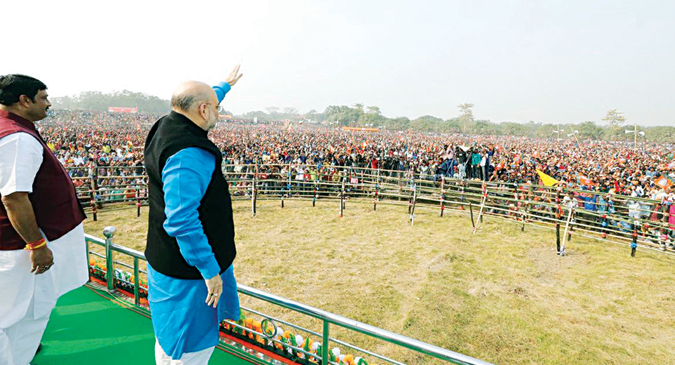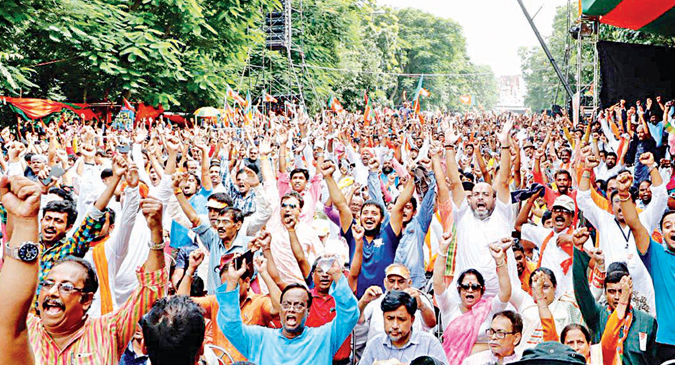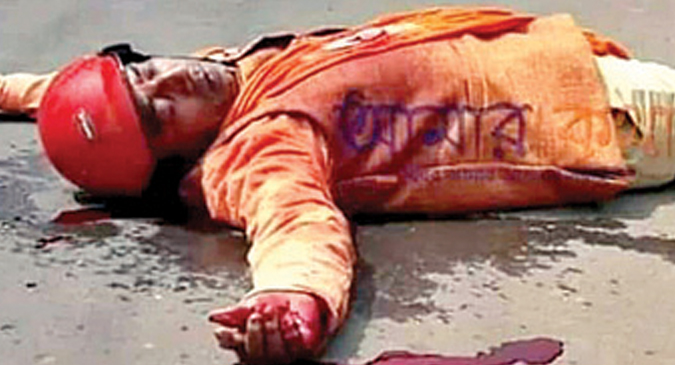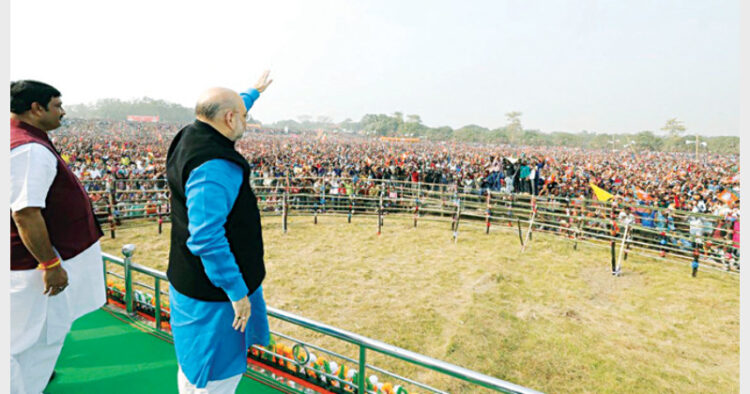People see BJP as the most viable substitute for TMC. The results of last Assembly, panchayat and byelections have proved that in the last few years BJP has gained fast and increasing acceptance and it has become the strongest competitor and substitute of TMC leaving behind Congress and CPM
Rantidev Sengupta
Chief Minister Mamata Banerjee has said that 42 out of 42 seats must be won; whereas BJP president Amit Shah has said that BJP must win 22 seats in West Bengal. Now that the dates of Lok Sabha elections have been declared, the voters of West Bengal are curious to see whether Mamata Banerjee will be successful in retaining the number of seats her party had won in the last Lok Sabha election, or will West Bengal be literally saffronised this time? Not only, will the impending Lok Sabha elections answer the question of who would be elected at the Centre, but will also act as a significant indicator, practically hosting a semi-final, before the coming election of the State Legislative Assembly in 2021. The results of this Lok Sabha election will clearly indicate the trend that will be followed in the 2021 State Legislative Assembly election.

BJP President Amit Shah during a rally held in Malda, West Bengal
If analysed in the backdrop of national polity, the central leadership of BJP has given special importance to the two eastern states—West Bengal and Odisha. It is an ingenuous blueprint of Amit Shah to establish a stronger pan-India presence of the party by producing startling results in these two states. It is also the tactful election strategy of this virtuoso veteran president of BJP that these two states will be instrumental in covering any deficit that may arise elsewhere in the country. However, the way in which the country is witnessing an unprecedentedly high spirit of nationalism subsequent upon the surgical air-strike by Indian Air Force in which the camps of terrorists at Balakot were destroyed, followed by the rippling and rapid transition of fates in the national polity, it seems unlikely that BJP may experience any such deficit in the impending Lok Sabha election. On the contrary, it would not be surprising at all if this time BJP ends up winning more seats than it had won in 2014 and this soaring spirit of nationalism would definitely have a remarkable ramification in the numbers in favour of BJP in some states.

General public during a rally addressed by BJP president Amit Shah
Coming back to the context of West Bengal, it is the biggest advantage of BJP that it has really nothing to lose in West Bengal and on the contrary, it has a partially unchartered but potentially conquerable territory ahead. Hence, BJP will stand to gain even if it is successful in securing a win in as many as ten seats in West Bengal, which will lay the foundation of its sure-footed journey towards the State Legislative Assembly election of 2021. However, in the event BJP is successful in touching the magic figure of 22 seats as projected by Amit Shah, conquer of West Bengal would be a matter of time. On the other hand, TMC, which is currently in occupation of 34 Lok Sabha seats, has touched the apex of political glory in West Bengal and has nothing to conquer. It is now more of a conscious struggle on the part of the TMC to retain what it had secured previously. Therefore, the popularity and existence of TMC will be at stake if even it wins one seat less than it had won in 2014, which would, without any doubt, be a harbinger of existential threat in the State Legislative Assembly election of 2021 for TMC, in the event it wins even one seat less now in comparison to 2014.

A BJP worker severly hit by West Bengal Police. CM Mamata Banerjee is using State machinery to supress the rise of BJP in Bengal
This time BJP is in a much favourable position in West Bengal with the Lok Sabha election around the corner. There was a time when BJP was averse to organise movements or, in other words, was not sufficiently equipped for political agitations, but which has been successfully overcome after Dilip Ghosh held the reigns of West Bengal BJP as its president and ever since he has been continuously touring from one district to another, holding public rallies, giving speeches in the meetings by motivating the party members. As a result, various districts are witnessing a rise in confidence in the party members and they have become pro-active in agitations, which has been making them a target of armed attack by TMC. This pro-activism in the party members is bound to produce positive results for BJP in the ensuing Lok Sabha election. At the same time, the ushering in of Mukul Roy is a respite for West Bengal BJP which was long suffering from dearth of a deft election strategist.
The history of West Bengal is awaiting a new dawn. It would not be surprising if the tempest of change sweeps more than 22 seats for BJP in West BengalAmit Shah has taken a tactical decision by entrusting Mukul Roy with the paramount responsibility of selecting candidates for Lok Sabha election. Roy has not only been successful in creating disintegration in TMC in some areas, but also has, very shrewdly, sown the seeds of mistrust and suspicion within the party members of TMC, so much so that the TMC supremo has been heard admitting that she knows which that members of her party are eager to join other parties. This proves that the TMC supremo herself is not in a position to trust the leaders of her own party and such lack of trust will definitely act as a deterrent for her party in the Lok Sabha election.
In this Lok Sabha election, effectively, the deterrent factors for TMC are, in a way, incentives for BJP. Admittedly, the main contest in this Lok Sabha election is between TMC and BJP, with Congress and CP(I)M not really in the forefront. It is definitely a major political achievement for BJP to rise from scratch to the position of the main competitor within the last few years. While even in the last Lok Sabha election people were not much bothered about how many seats would be won by BJP, this time the same people are wondering whether BJP will be able to topple the government of TMC supremo, which shows that people have already selected BJP as a substitute of TMC by disregarding Congress and CP(I)M.
It cannot also be disputed that the popularity and public trust which Mamata Banerjee carried with herself while taking the reins of West Bengal in her hands as Chief Minister in 2011, has considerably dwindled in 2019, that is, in the last eight years, of which even the TMC supremo herself was clueless.
Mamata Banerjee did not win the election in 2011 by playing any communal card. She had called out for uprooting CP(I)M from the soil of West Bengal and majority of the Hindu-Muslim electorate responded to her clarion call which had sounded like temple bells and ‘azaan’ to their ears as they were dejected with the mis-governance of CP(I)M. However, upon coming to power, the same Mamata Banerjee started compromising on injustice and political appeasement of Muslims, which are the core reasons for the drastic fall in her popularity and public trust with the majority electorate. This excessive appeasement for petty political gain, along with “syndicate raj”, hooliganism, unabated illegal collection of money and an overall deterioration in law and order have distressed the majority electorate of West Bengal, which may pose a potential danger to TMC in the ensuing Lok Sabha election. Mamata Banerjee and her government have even committed the sin of plundering with the democratic rights of the people of West Bengal. The last Panchayat election was reduced to a farce. Moreover, the majority electorate of West Bengal have also witnessed myriad other misdeeds such as implicating and harassing members of the Opposition parties in false cases, denying permission to hold meetings and rallies by the Opposition parties, etc., which have only damaged the images of Mamata Banerjee and her party and which will take its toll in the ensuing Lok Sabha election. Above all, the maximum damage inflicted upon Mamata Banerjee is her self-proclaimed image of impeccable honesty that has been tainted with the financial scams in Sarada, Narada and Rose Valley, after which nobody would agree to award a certificate of honesty either to Mamata Banerjee or her party.
BJP’s advantage is that it has never been in power in West Bengal and therefore there has been no occasion for any stigma or disappointment to be attached to it. Mamata Banerjee will have to address the distress, when the same distress will gain momentum for BJP in the ensuing Lok Sabha election. Mamata Banerjee had taken advantage of this identical opportunity during the 2009 Lok Sabha election and 2011 State Legislative Assembly election against CP(I)M. This time the same advantage is with BJP to take.
There is a noticeable apathy for TMC in West Bengal in the ensuing Lok Sabha election. It is only after witnessing the eight-year long governance of TMC that the people of West Bengal are saying—there is a need to re-change the change. The hope, trust and expectation with which the people of West Bengal had ushered in TMC by removing CP(I)M, have been totally broken. They also do not trust CP(I)M after having witnessed the utter mis-governance over a period of 34 years and there is hardly any significance of Congress in West Bengal. Therefore, people see BJP as the most viable substitute of TMC in West Bengal. The results of the last State Legislative Assembly, panchayat election and by-elections of some other constituencies have proved that in the last few years BJP has gained fast and increasing acceptance and it has become the strongest competitor and substitute of TMC by leaving behind Congress and CP(I)M.
The obvious question that would arise in such an advantageous situation for BJP is, how many seats can BJP expect to win in West Bengal in the ensuing Lok Sabha election? Amit Shah has been emphasising from the very beginning that BJP must secure victory in at least 22 seats in West Bengal. Having visited different constituencies of Lok Sabha in West Bengal, one can say that Amit Shah has not stated anything utopian. On the contrary, such number has been calculated after a close and detailed observation of the different constituencies of the Lok Sabha in West Bengal. The constituencies of south Bengal where BJP has a fair chance of success are—Bankura, Purulia, Asansol, Burdwan-Durgapur, Hooghly, Krishnagar, Ranaghat, Kolkata North, Kolkata South, Dum Dum, Midnapur, Jhargram, Howrah, Bongao, Barrackpore and Basirhat. Among these constituencies, BJP had performed extremely well in Bankura, Purulia and Jhargram in the last panchayat election. After Arjun Singh, a Member of Legislative Assembly from Barrackpore constituency joined BJP by leaving TMC, BJP’s chance of success in Barrackpore has increased manifolds. The electorates from constituencies in cities and industrial belts like Asansol, Burdwan-Durgapur, Kolkata North, Kolkata South, Howrah have been increasingly losing hope, confidence and trust in TMC. The electorates of the constituencies like Krishnagar, Bongao, Basirhat, Hooghly, that comprise of Hindu majority, are mostly united against TMC.
Among the constituencies of North Bengal, BJP has a fair chance of success in Balurghat, Raigunj, Coochbehar, Alipurduar and Malda North, the electorates whereof have become dejected with the hooliganism and appeasement of Muslims. A fair idea of the outcome in the constituencies can be assessed from the above discussion. There are still constituencies apart from those discussed above where a radiation of the impending change of power can be felt. It would not be surprising if the tempest of change sweeps more than 22 seats for BJP in West Bengal.
It is apparent and evident from the conduct of the leaders and members of TMC that it is now a drowning ship and the trend of dumping TMC by them is mainly due to the despotic and autocratic attitude of Mamata Banerjee and her nephew Abhisek Banerjee. Then there are distressed party members, who are even ready to teach their party a lesson in the ensuing Lok Sabha election from within the party. On top of it, the deployment of central paramilitary forces early this time has ensured that victory by rigging votes is no more possible now. Sensing the danger Mamata Banerjee and her associates have already started a demonstration demanding that none of the constituencies of West Bengal can be declared as ultra-sensitive, thereby, in other words demanding that they ought to be given the liberty of rigging. Their conduct itself is sufficiently exposing the panic in their minds.
The month of May 2019 may usher in a change. The history of West Bengal is awaiting a new dawn. It is just a matter of time.














Comments